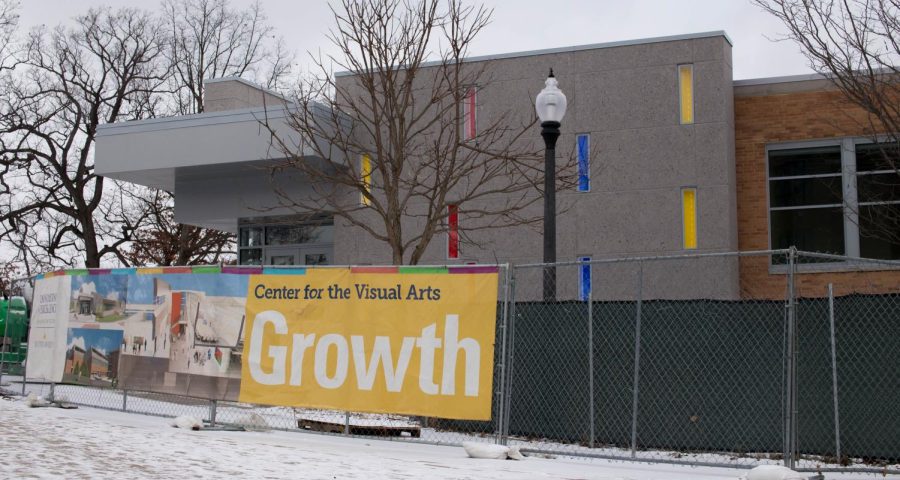Construction materials monitored for hazards
The Center for Visual Arts on Monday, Jan. 18, 2016. The building has been delayed until the spring of 2017 after asbestos was found in older parts of the building.
January 31, 2016
With the recent construction efforts and pursuit to improve existing buildings on campus, members of the Kent State community may be concerned about coming into contact with harmful building materials such as asbestos.
The Environmental Health and Safety department, as well as University Facilities Management, work together to make sure students, faculty and staff are protected from risk and are properly informed about any concerns regarding asbestos and harmful materials. If students have a concern, they can always request information from the department.
“We just have a standing program that we will share information based on the request of the student,” said Roy Christian, director of Operations and University Facility Management for Kent State.
Asbestos is a heat resistant, fibrous material that occurs in rock and soil. It was often used in buildings constructed prior to the mid 70s when the Environmental Protection Agency passed a series of bans on certain products that contained asbestos. Not all products that contain asbestos are currently banned by the EPA, but the regulation does ban all new uses, meaning manufacturers can not add it in products that haven’t historically contained it. It can also be found in vinyl floor tile, roofing shingles and other industrial materials.
Asbestos exposure is linked to lung cancer and mesothelioma, a rare form of cancer found in the lining of the lungs, chest, abdomen and heart. To be considered exposed, the fibers have to be released into the air during a disturbance to the material, such as construction work.
“We don’t want to sensationalize or make it more than it is because it is better to not do anything with it at times,” Christian said.
Dennis Baden, Director of Environmental Health and Safety, also said that members of the Kent State community have no reason to be worried about an exposure risk from some of the older buildings on campus.
“Any of our buildings that contain asbestos, we are now aware of where they are, so we manage those,” he said. “As long as they are intact, they represent absolutely no risk to any building occupants, visitors, students or anything like that.”
The primary group of people at risk of having an exposure are members of the maintenance staff, who may perform tasks disturbing the material.
“The permissible exposure limit for asbestos is 0.1 fibers per cc for eight hours,” Baden said.
During training, workers are taught about health hazards and how to find information on what materials contain asbestos.
“All maintenance employees at the university have asbestos awareness training,” said Baden.
When it comes to daily maintenance of the buildings, steps are also taken to make sure these employees, who may not actively disturb the materials, are protected.
“(With) some of the older buildings, first of all, you’ve got to be aware of the surroundings; what’s on the units (and) whether there’s any material that you have to deal with carefully,” Christian said. “As they age, they don’t age gracefully, so we have to be careful how we go about doing things.”
Another concern that can come with a building environment is mold, a fungus that occurs from any damp or decaying organic substance. While there are many types of mold that can become present in an indoor environment, the variety that can cause the most concern is Stachybotrys chartarum or black mold, which can release harmful toxins into the air, according to the CDC.
“That’s one of those things where you’ve got a perfect room and all of a sudden you’ve got mold and you’ve got to deal with it,” Christian said.
At the university, the procedure for mold removal depends on how severe the problem is. If isolated to a small area, maintenance staff will clean the affected surface thoroughly, Baden said. If the area is large, maintenance contacts the Environmental Health and Safety office.
Both the facility and department of Environmental Health and Safety make sure the process is also clean for construction workers. Christian said that if asbestos is present in a building being remodeled, a certified contractor is hired to remove it and sends the material to an approved landfill for the material to be disposed of.
Christine Havice, director for the School of Art, said that the new Center for the Visual Arts building had asbestos in it abated before the building process took off.
The new building is to be LEED certified silver building when it is completed, according to Havice. This is a huge improvement from where universities used to be as far as building upkeep is concerned, she said.
“Universities went through a period where there wasn’t much money being dedicated to building or even maintenance,” said Havice.
If students or faculty members have an issue with mold, water damage or any concerns about the buildings on campus, they are encouraged to call the maintenance department, Baden said.
“By all means, if someone wants to call me directly … at Environmental Health and Safety … we will investigate it as well,” he said. “But I think your first (step) normally, for issues like mold and other things, would be to contact the maintenance department first.”
Olivia Minnier is the administration reporter for the Kent Stater. Contact her at [email protected].

























